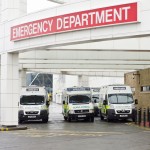
Katerina Kavalidou reviews a prospective observational cohort study on mortality and suicide risk in young people after they present to hospital emergency departments following episodes of self-harm.
[read the full story...]
Katerina Kavalidou reviews a prospective observational cohort study on mortality and suicide risk in young people after they present to hospital emergency departments following episodes of self-harm.
[read the full story...]
Kirsten Lawson is frustrated by the uncertainty highlighted in a recent systematic review of the epidemiology of mental health attendances at emergency departments.
[read the full story...]
Olivia Maynard summarises a systematic review of smoking cessation interventions in the emergency setting, which highlights the poor quality and heterogenous nature of the published trials in this field.
[read the full story...]
Can’t get an appointment with your GP? Don’t stress, mindfulness-based cognitive therapy may help by reducing the demand for primary care visits by distressed patients, according to a new study in the Journal of Psychosomatic Research.
[read the full story...]
A new study finds that psychiatric medications are implicated in many adverse drug events treated in US emergency departments. Nearly 1 in 10 of all adverse drug event visits to emergency departments are due to psychiatric drugs, including antidepressants, antipsychotics, lithium salts, sedatives, anxiolytics and stimulants.
[read the full story...]
Liaison psychiatry brings together medical and psychiatric staff in hospital wards and emergency departments, with the aim of more adequately addressing comorbidities between physical and mental health. It’s something that’s been discussed in the Woodland before, with recommendations for wider implementation. The Guardian recently published an article discussing the findings of a recent study and [read the full story…]

While depression is the leading cause of disability for both males and females, the burden of depression is 50% higher for females. In fact, depression is the leading cause of disease burden for women in both high-income and low- and middle-income countries (WHO, 2008). Research has shown that women with unidentified and untreated maternal depression [read the full story…]

Last September I blogged about a cohort study in the Lancet that highlighted the links between self-harm and poor physical health. This same dataset (drawn from over 30,000 patients from 6 hospitals in Oxford, Manchester and Derby from 2000-7) has now spawned a longitudinal study published in the European Child and Adolescent Psychiatry journal. This [read the full story…]

The prevention of suicide in inpatient mental health settings has long been a focus for clinicians and managers. Understanding what can be done in community, emergency and general practice settings to reduce the number of suicides has presented more of a challenge. This briefing introduces the National Patient Safety Agency’s (NPSA) new suicide prevention toolkits [read the full story…]

Screening for alcohol misuse in the emergency department needs to be done quickly and accurately, so it makes sense to find the best instrument for this purpose. This systematic review of diagnostic cohort studies searched a range of databases and journals and also conducted citation searching because of a lack of relevant literature found by [read the full story…]